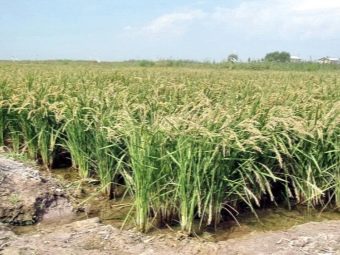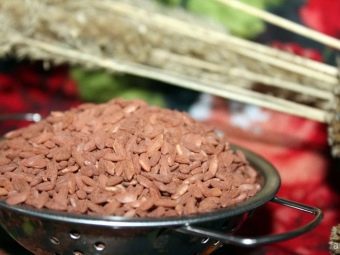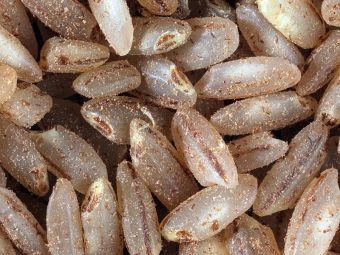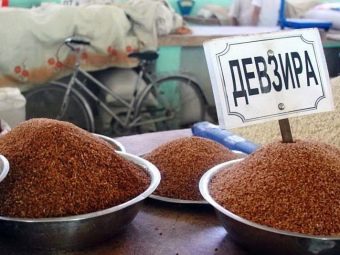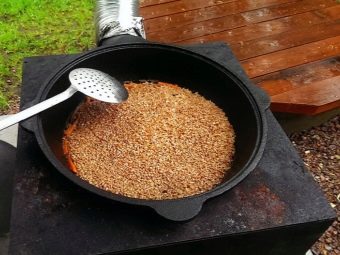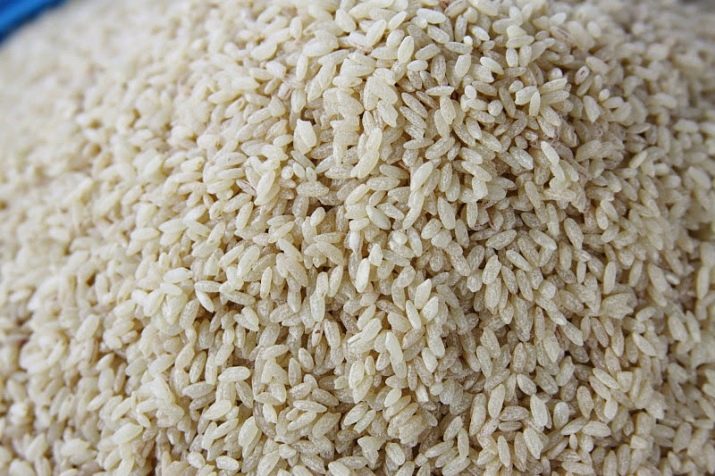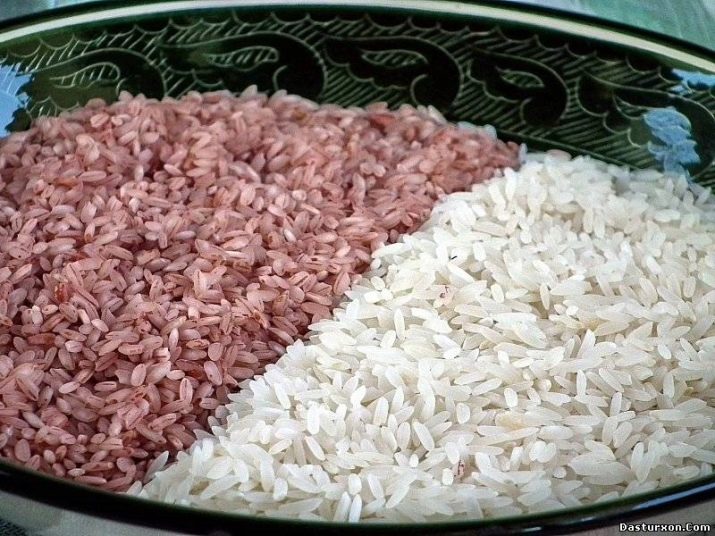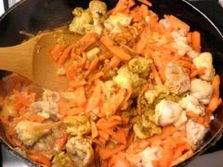Features of Uzbek rice Devzira
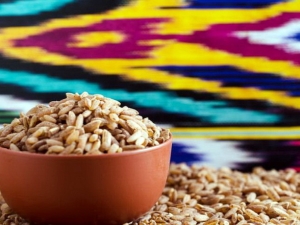
Rice is present in the diet of almost every person. Today there are dozens of varieties of this product.One of the most useful and high-quality varieties of such cereals is Devzira Uzbek rice. From it prepare amazing oriental dishes that can not leave anyone indifferent.
What it is?
Devzira is an expensive and very high quality rice variety. It is a light brown grain with a red tint. After washing in cool water, it acquires a noble amber color. Connoisseurs of fragrant and delicious dishes use only this rice to make real oriental pilaf.
Devzira rice grows in the expanses of Central Asia in the Fergana Valley near the Syr Darya River. For many years in Uzbekistan this variety of cereal is called “pink pearl”. The secret of growing this variety is that it grows in a sharply continental climate, near the river water. Also of considerable importance for growth is a certain soil composition.
Local farmers harvest twice a year. The first shoots of rice appear at the beginning of summer straight out of the water, the ears themselves are mowed not earlier than October. After harvest, proceed to drying. It lasts at least a year. In winter, the product is treated with particular care, not allowing it to sniff. With the arrival of spring, the rice is carried to fresh air, where it is dried naturally.
Devzir’s rice is shelled but not sanded. Because of this, it retains all its useful properties. During the heat treatment, the grains do not lose their shape and increase in volume by 8 times.
Composition and glycemic index
Devzira refers to the slightly polished form of cereals, on which you can even see the remains of the shell. It is distinguished from ordinary ground rice by its color gamut, high nutritional value and increased protein content (more than 12%).
Rice, which is not processed, retains maximum useful qualities that are in the seed and seed. Groats contain a lot of fibers and antioxidants that strengthen the work of the gastrointestinal tract, as well as cleanse it of toxins and protect against harmful effects. As part of the Uzbek cereal there are trace elements useful for the human body (magnesium, iron, phosphorus, selenium, zinc) and a rich vitamin complex, including vitamins B and E.
The energy value per 100 grams of dry rice Devzira is 370 kcal.
The ratio of BZHU in the product:
- proteins - 9.5 g;
- fat - 0.9 g;
- carbohydrates - 80.6 g
It should be emphasized that rice does not contain GMOs and is grown in favorable environmental conditions. The glycemic index of this type of cereal is 55, which is an average. The product is approved for use by people who want to lose weight, as well as people with type 1 and 2 diabetes. Rice normalizes blood glucose and lowers cholesterol.
Benefit and harm
Devzira Rice is known for its beneficial properties and has practically no contraindications. We study in more detail the positive and negative sides of the product.
Benefit:
- dishes from Uzbek cereals increase hemoglobin levels quite well;
- fiber, which is part of the product, improves intestinal motility and removes toxins from the body;
- eating rice strengthens the nervous system, relieves migraines and prevents the development of cardiovascular and endocrine diseases;
- the product normalizes blood pressure;
- it also improves the growth of nails and hair, strengthens bones;
- thanks to the valuable components of the product, the skin becomes healthy;
- trace elements contained in the grains contribute to the removal of excess salt from the body;
- phosphorus in the composition of rice Devzira useful for tooth enamel;
- selenium helps reproductive health of men and women;
- the absence of gluten in rice makes it possible to add it to the diet of people with celiac disease;
- Antioxidants help strengthen the immune system, preventing inflammation.
Harm:
- with excessive use of rice may develop flatulence and intestinal dysfunction;
- the use of this very high-calorie meal more than 3-4 times a week contributes to weight gain
- Silicon is present in any rice variety, and if products containing this element are abused, an exacerbation of urolithiasis may occur.
Varieties
Currently, there are several major subspecies of Uzbek rice.
- Chungara. This unusual name was received from the name of the Kyrgyz settlement, in which this variety was first cultivated. Grains are a dense consistency of snow-white color. They contain less starch than other types of rice. Pilaf made from this variety has a spicy taste and a pleasant aroma. When cooking, the product perfectly absorbs fat, but remains surprisingly crumbly.
- "Dastar-saryk." This is a variety of rice grown in the city of Uzgen. Cereal is carefully stored in bags for several years, periodically pouring water. Then it is smoked to give the product a yellow tint and a certain smell. Due to the long storage of the grains become hard, they make delicious pilaf.
- "Bark koltak". Translated from the Turkic language, this means "black stick". Its only difference is the presence of black, not red, stripes on the grains.
- "Laser" ("Lazar"). This subspecies of rice is grown in Khorezm - the historical region of Uzbekistan. The croup has a soft white structure. Unlike all other cereals, it slightly increases in size. Connoisseurs of oriental dishes often buy exactly the sort “Laser” for cooking pilau.
- "Alanga." This is one of the most popular and budget types of Uzbek rice. It has large and dense grains of a beautiful pearl shade.
How to choose and distinguish from fakes?
You can buy Devzira rice in large supermarkets. You can also buy it through the online store or select it on the market.
To determine the authenticity of cereals is not easy.
- First of all, you should focus on the cost of the product. This variety of cereals is not cheap, it costs no less than wild rice.
- If possible, touch the cereal. Rice grains have a pleasant to the touch surface, it seems as if they are covered with a layer of powder. They can be both soft pink and red-brown hue. When touching the grains, the powder covers the fingers in a uniform layer, without creating a rustling.
- The longer the shelf life of rice, the more expensive it will be. Experienced farmers, to achieve the best taste of grain, kept it in a dark place for several years, occasionally irrigating with water.
- If you drop Devzira’s real rice into water, it will not leave dirty sediment and stain the liquid.
Some unscrupulous manufacturers fake this valuable product. They paint it with dust from ground brick to give the croup the desired shade. Such a fake has nothing in common with natural Uzbek rice. A fake look of cereal will not only spoil the taste of the dish, but may also have a negative impact on your health.
From the published consumer reviews, it can be concluded that one of the highest quality and best rice growers in Russia is the National brand. Also, buyers note that the product of this manufacturer can be purchased in stores at an affordable price. On the label of rice "National" you can see several recommendations for the preparation of pilaf.
Cooking recipes
Devzira Rice is ideal for the realization of culinary masterpieces. It is used for cooking pilaf, side dishes and various desserts. Of course, the most popular dish using Uzbek rice is Fergana pilaf. For Uzbeks, it is considered a national dish and is prepared for all festive events. It is customary to cook it in a large cauldron. The advantage of a cauldron is that heat is evenly distributed in it.
Before preparing pilau, it is recommended to soak the cereal in warm water for at least 20 minutes. Then rinse it thoroughly. Thanks to the pre-soaking, the kernels will have a mouth-watering appearance and will be prepared faster. For real eastern pilaf, it is recommended to buy mutton. Choose meat carefully, it should be fresh, without foreign smell.
Fergana plov
To cook the Fergana plov you will need the following products:
- lamb - 1 kg;
- Devzira rice - 1 kg;
- carrots - 1 kg;
- sunflower oil - 350 ml;
- onion - 1 kg;
- garlic - 4 cloves;
- barberry, zira (cumin) - to taste.
Stages of cooking:
- heat the dishes with a thick bottom (cauldron) over high heat;
- pour oil into the pan and warm up for 7-10 minutes;
- when the oil is hot, pour chopped onions into the cauldron and fry until golden brown (the onions will give the pillow an unusual smell and a beautiful shade);
- gently add pieces of meat to the onion and fry them until a crust appears, stirring occasionally with a wooden spoon;
- add carrots cut into thin plates to fried foods;
- in the resulting mixture (zirvak) pour boiling water, which will cover all the ingredients;
- add salt and zivrak spices;
- cover the pan and reduce the heat, leaving meat and vegetables to stew for 25-30 minutes (from this point there is no need to change the level of fire);
- after the specified time, add cereal to the zirvak and pour boiling water (the water level should be higher than all the prepared ingredients by a couple of centimeters);
- add whole garlic heads to the pilaf (to do this it is not necessary to completely clear them);
- when rice is fully prepared, you do not need to immediately open the lid and remove the dish from the stove, it is recommended to let the pilva brew for at least an hour (the dish should turn out crumbly, but not raw);
- gently mix the pilaf with a skimmer and place it on a flat plate.
In Central Asia, it is customary to serve pilaf with tomatoes and ripe pomegranate. It is worth noting an interesting fact: many wealthy Uzbek families, playing weddings, invite the best chefs from the city of Fergana so that the married life of the newlyweds can be nourishing, like traditional Ferghana pilaf.
Uzbek Chicken Plov
Those who do not like lamb can cook Uzbek Uzbek plov.
Ingredients:
- chicken fillet, breast - 0.5 kg;
- Devzira rice brand "National" - 0.5 kg;
- onions - 4 pieces;
- garlic - 3 cloves;
- carrots - 0.5 kg;
- vegetable oil - 100 ml;
- ground coriander - 1 tbsp. l .;
- Zira (Cumin) - 1 tbsp. l .;
- Paprika and ground pepper - 1 tbsp. l .;
- salt - to taste.
Cooking process:
- cut meat into cubes of medium size;
- onion and carrot shred;
- sauté vegetables in a deep frying pan over high heat to a beautiful golden color;
- add chicken to vegetables and fry until cooked;
- transfer the mixture to a thick-bottomed pot or cauldron, add spices;
- washed cereal pour into the cauldron and put garlic cloves into the zirvak;
- pour boiling water over zirvak so that the water covers 1-1.5 centimeters (do not mix until the dish is ready)
- after 30-40 minutes, you can open the lid of the pan and mix the resulting chicken pilaf;
- if time permits, let the dish stand for a couple of hours.
To learn how to cook Uzbek pilaf from Devzira rice, see the following video.


